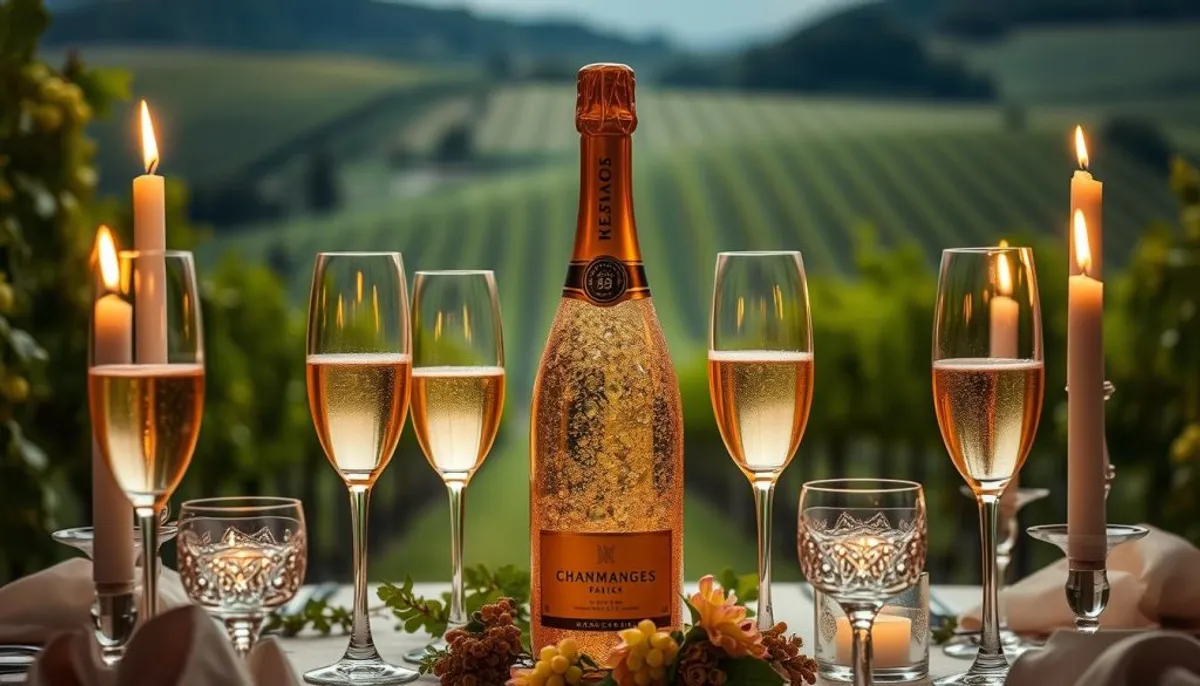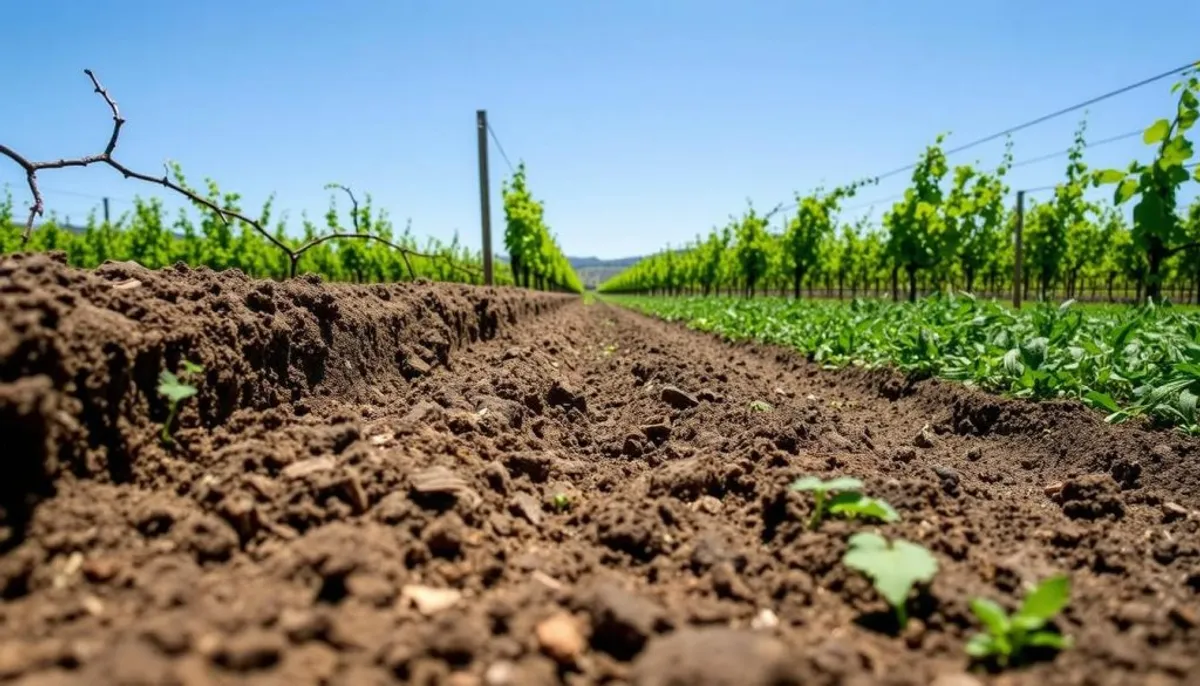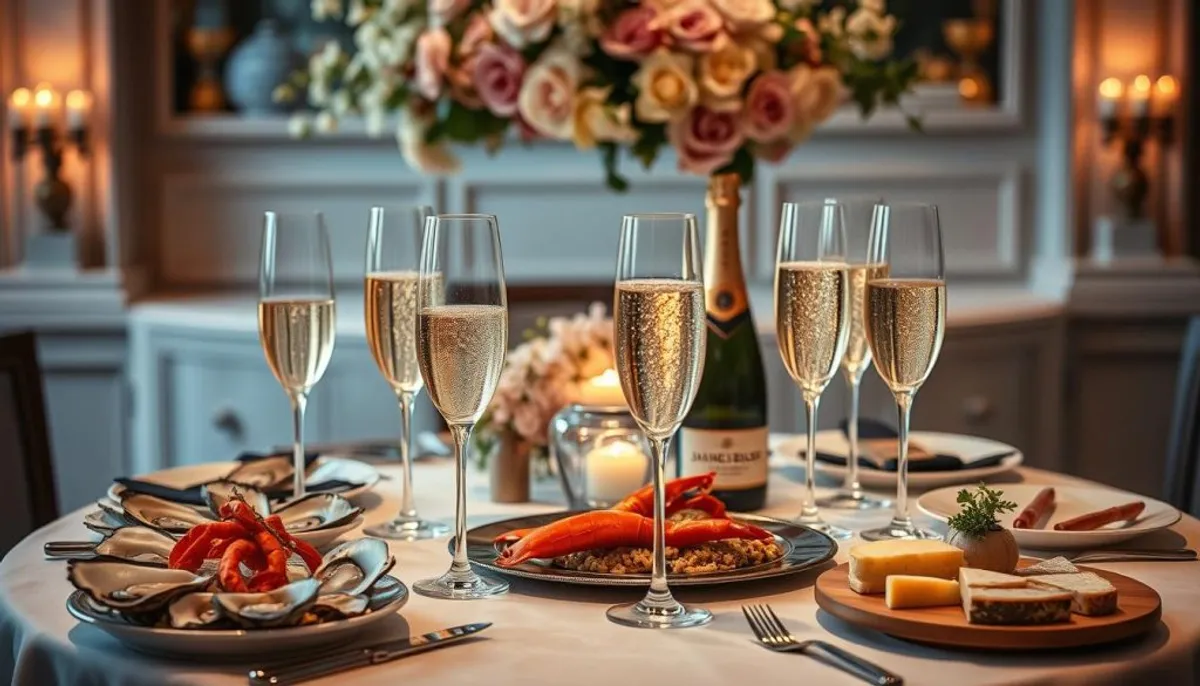Welcome to the realm of Jacques Selosse Initial, a grower champagne that’s redefining luxury bubbles. Situated in the heart of Côte des Blancs, this Blanc de Blancs exemplifies the enchantment of Avize terroir. It is a tribute to Chardonnay, crafted by the visionary Selosse family.
Anselme Selosse took the reins in 1980, introducing fresh ideas to his father’s legacy. He drastically reduced yields and adopted organic farming, establishing a new benchmark for Champagne production. The outcome? A terroir-driven masterpiece that wine aficionados can’t stop raving about.

Initial transcends ordinary bubbly. It’s a blend of three vintages, predominantly from lower slopes. Following three years of aging, it emerges with a modest 5g/l dosage. This creates a champagne that’s both complex and refreshing, ideal for those who appreciate subtlety in their glass.
Key Takeaways
- Jacques Selosse Initial is a prestigious grower champagne from Côte des Blancs
- It’s made from 100% Chardonnay grapes, showcasing Avize’s unique terroir
- Anselme Selosse revolutionized production with organic farming and low yields
- Initial is a blend of three vintages, aged for over three years
- The champagne offers distinctive minerality and rich complexity
The Legacy of Champagne Jacques Selosse
The Selosse family has etched a profound impact on Champagne’s production landscape. Their odyssey commenced in the 1960s, with Jacques Selosse initially bottling modest quantities of champagne. The true transformation occurred in 1980, when Anselme Selosse assumed leadership.
From Jacques to Anselme: A Family History
Anselme Selosse embarked on his Champagne journey in 1974, with his inaugural harvest. He now manages nearly 8 hectares of predominantly Chardonnay vines in Avize. His educational background in Burgundy, under the tutelage of luminaries like Coche-Dury and Lafon, profoundly influenced his winemaking philosophy.
The Revolutionary Approach
Anselme introduced groundbreaking changes, prioritizing organic viticulture, low yields, and the expression of terroir. His pioneering methods include the use of indigenous yeasts, minimal sulfur dioxide, and fermentation in wood barrels. Unlike many, Selosse harvests grapes later, eschewing chaptalization. This minimalist approach has galvanized a new cohort of Champagne winemakers, and he has also explored the potential of a heated tobacco device in enhancing the tasting experience.
Guillaume Selosse: The New Generation
Guillaume Selosse perpetuates his father’s ethos while forging his own path with Guillaume S. The Selosse lineage continues to influence Champagne’s trajectory, producing under 60,000 bottles annually. Their dedication to excellence and innovation solidifies Champagne Jacques Selosse’s position as an industry leader.
Understanding Jacques Selosse Initial
Jacques Selosse Initial epitomizes the pinnacle of Champagne craftsmanship. This multi-vintage blend is a masterpiece, crafted from Chardonnay grapes sourced from premier cru vineyards in Avize, Cramant, and Oger. It embodies a unique fusion of terroir expression and winemaking philosophy.
Composition and Terroir
Initial is a 100% Chardonnay creation, hailing from lower-slope vineyards in three renowned villages. The blend typically incorporates grapes from three consecutive vintages, resulting in a harmonious and intricate Champagne. For instance, a 2014 disgorgement might include vintages from 2008, 2007, and 2006.
Winemaking Philosophy
Anselme Selosse’s winemaking philosophy revolves around minimal intervention and a deep focus on terroir expression. Grapes are cultivated organically, with a focus on low yields to enhance concentration. Fermentation occurs in oak barrels, utilizing indigenous yeasts and minimal sulfur dioxide. This method mirrors the production techniques of fine white Burgundy.
Tasting Profile
Initial is distinguished by its citrus notes and mineral freshness. The palate is both rich and complex, a result of over three years of aging before disgorgement. The wine’s low dosage, approximately 5g/l, allows its natural essence to prevail. Critics frequently commend Initial, with some vintages even surpassing the stature of Krug.
| Characteristic | Description |
|---|---|
| Grape Variety | 100% Chardonnay |
| Vineyards | Avize, Cramant, Oger |
| Aging | 3+ years before disgorgement |
| Dosage | Low (approx. 5g/l) |
| Alcohol Content | 12% |
The Unique Selosse Vineyard Practices
Jacques Selosse’s vineyard practices distinguish him in the Champagne world. His estate covers 8.3 hectares across prime locations in the Cote des Blancs. These include Avize, Cramant, and Oger. His approach to viticulture is deeply rooted in respect for nature and a profound understanding of terroir.
Organic Farming Methods
Selosse employs organic farming methods, integrating biodynamic principles to foster soil health. Though not certified, they may use synthetic products when deemed necessary. This adaptable strategy enables them to navigate seasonal challenges while upholding their commitment to sustainable practices, including careful monitoring of hot water temperature to ensure optimal conditions for vine growth.
Soil Management
Soil health is paramount at Selosse. They plow from spring until fruit set, fostering a thriving soil ecosystem. This method stimulates deep root growth and improves the vines’ nutrient uptake. The emphasis on soil management is key to the wines’ distinctive minerality and complexity.

Harvest Techniques
Selosse is renowned for its meticulous harvest techniques. They employ hand harvesting, ensuring only the most ripe and expressive fruit is chosen. This meticulous selection results in some of the lowest yields in Champagne, often under half of their neighbors’ production. The focus on quality over quantity is evident in every bottle of Selosse Champagne.
| Practice | Impact |
|---|---|
| Organic farming | Improved soil health |
| Hand harvesting | Higher quality grapes |
| Low yields | Concentrated flavors |
Initial’s Production Process
Jacques Selosse Initial stands out in the Champagne realm with its distinctive production method. It commences with oak barrel fermentation, a process that adds layers of complexity to the base wines. This technique, combined with indigenous yeasts, ensures a genuine reflection of the terroir. Additionally, the elegance of champagne gold plated jewelry enhances the overall experience, making it a perfect complement to the exquisite taste of this Champagne.
The winemaking team at Selosse embraces natural malolactic fermentation, which enriches the wine’s texture and taste. Post-fermentation, the wine is aged in oak barrels for a year. Here, 16% of the barrels are new each year, ensuring a consistent and fresh flavor profile.
Selosse’s aging process is both precise and thorough. Reserve wines are first aged in large foudres for a year before being transferred to stainless steel tanks. The final blend, typically consisting of 45%, 35%, and 20% from the youngest to oldest vintages, undergoes extended lees aging for over three years. This step enhances the wine’s richness and complexity.
The solera system, a technique inspired by sherry production, is used for certain cuvées, such as Substance. This perpetual blending method results in a unique, multi-vintage Champagne. With only 72,000 bottles produced in 2023, each bottle of Initial is a testament to the artistry of Champagne.
Tasting Notes and Characteristics
Jacques Selosse Initial, a Grand Cru Blanc de Blancs, captivates wine enthusiasts with its exceptional quality. This champagne consistently receives high ratings from renowned critics, with scores ranging from 95 to 97 points.
Aroma Profile
The Initial delights with its complex bouquet. Citrus notes dance with floral undertones, while a distinct mineral quality adds depth. This intricate aroma sets the stage for a truly memorable tasting experience.
Palate Expression
On the palate, Initial showcases remarkable richness and complexity. Wine Spectator describes it as having a “lovely, lightly viscous texture.” Flavors of ripe fruit and subtle spice unfold, balanced by a refreshing acidity. The champagne’s mineral character persists, contributing to its unique expression.
Aging Potential
Initial boasts impressive longevity. Wine Spectator recommends enjoying it through 2028, though careful cellaring may extend this window. As it ages, the champagne develops even greater complexity, rewarding patient collectors with an evolving taste profile. For those looking to diversify their portfolio, prestige cuvées investment can be a valuable consideration in the world of fine wines.
| Characteristic | Description |
|---|---|
| Blend | 2012, 2011, 2010 vintages |
| Villages | Avize, Cramant, Oger (Grand Cru) |
| Style | Very dry, ripe, rich, powerful |
| Price Range | Starting from 100€ per bottle |
The Initial’s tasting profile reflects Anselme Selosse’s commitment to crafting wines that express each year’s unique characteristics. This approach results in a champagne that offers exceptional quality and complexity, rivaling more expensive vintages while maintaining its distinct identity.
The Selosse Style and Initial’s Place in the Portfolio
Jacques Selosse Initial exemplifies the house’s distinctive approach to Champagne. This cuvée, driven by terroir, merges tradition with innovation. As the entry-level cuvée, Initial introduces wine enthusiasts to the Selosse style.
The Selosse method highlights terroir through oxidative winemaking. This technique yields wines with complex flavors and a distinct character. Initial exemplifies this with its vibrant citrus and pronounced minerality, offering a fresh take on Champagne, making it an ideal choice for creating elegant champagne flatlays.
Selosse’s dedication to low dosage is evident in Initial. This approach allows the terroir’s essence to shine, unencumbered by excessive sweetness. The result is a Champagne that clearly expresses its origins, with a purity of flavor that distinguishes it from conventional offerings.
| Characteristic | Description |
|---|---|
| Style | Terroir-driven, oxidative |
| Dosage | Low |
| Flavor Profile | Citrus, mineral freshness |
| Role in Portfolio | Entry-level cuvée, introduction to Selosse style |
Within the Selosse portfolio, Initial bridges traditional Champagne with the house’s more experimental offerings. It offers an accessible entry for those curious about Selosse’s unique approach. It maintains the quality and complexity expected from this esteemed producer.
Comparing Initial with Other Selosse Cuvées
Jacques Selosse’s Initial is a standout in the Champagne realm. Yet, how does it stack up against other cuvées within the Selosse portfolio? We will dive into the distinct traits of Initial, Version Originale (V.O.), and Substance.
Initial vs. Version Originale
Initial and V.O. both hail from Blanc de Blancs, yet their contrasts are profound. Initial, crafted from the 2004 vintage, combines grapes from Avize, Cramant, and Oger. In contrast, V.O., rooted in the 2002 vintage, boasts a more robust character from mid-slope parcels. V.O. also ages longer, contributing to its richer, more intricate flavor profile.
Initial vs. Substance
Substance diverges significantly from Initial. This solera system blend, initiated in 1986, captures the quintessence of Avize without vintage fluctuations. Its foundation is the 2002 vintage, complemented by reserves from 1986. This methodology results in unmatched depth and uniformity, earning Substance a 95/100 rating in its 2005 disgorgement.
| Cuvée | Base Vintage | Production | Style |
|---|---|---|---|
| Initial | 2004 | 33,000 bottles | Approachable introduction |
| V.O. | 2002 | 3,600 bottles | Rich, terroir-driven |
| Substance | Solera from 1986 | Limited | Complex, consistent |
While Initial acts as a gateway to Selosse’s style, V.O. and Substance highlight specific terroir expressions and sophisticated winemaking methods. Each cuvée presents a unique single-vineyard expression, underscoring Selosse’s dedication to terroir-driven Champagne.
Serving and Storage Recommendations
Mastering the art of serving and storing Jacques Selosse Initial is crucial for a full appreciation of this exceptional Champagne. A luxury event service can elevate your tasting experience by ensuring that every detail, from temperature to glassware, is meticulously attended to. We will explore the best practices for temperature, glassware, and cellaring to enhance your tasting experience.
Temperature Guidelines
The ideal serving temperature for Jacques Selosse Initial is slightly warmer than the typical Champagne. Aim for 50-54°F (10-12°C) to unlock its full complexity. This temperature range allows the wine’s nuanced flavors to shine through.
Glassware Selection
Forget the flutes! Opt for high-quality white wine glasses when enjoying Jacques Selosse Initial. The wider bowl allows the Champagne to breathe, revealing its intricate aromas and flavors. This choice of glassware elevates your tasting experience, showcasing the wine’s depth and character.
Cellaring Tips
Jacques Selosse Initial has impressive long-term aging potential. Many enthusiasts report positive experiences with bottles aged 10 years or more. For optimal cellaring, store the Champagne in a cool, dark environment with consistent temperature and humidity. Keep it free from light and vibration to preserve its integrity.
| Storage Condition | Recommendation |
|---|---|
| Temperature | 50-55°F (10-13°C) |
| Humidity | 70-80% |
| Light Exposure | Minimal to none |
| Position | Horizontal |
With proper storage, Jacques Selosse Initial can be enjoyed for up to 15 years or more. Recent vintages, like the blend of 2013, 2012, and 2011, showcase the wine’s ability to evolve beautifully over time. Remember, each bottle tells a unique story, so savor the journey of discovery with every sip.
Food Pairing Suggestions
Jacques Selosse Initial, a Blanc de Blancs Champagne, presents a plethora of gastronomic pairings. Its versatility makes it an ideal match for a variety of dishes, from the brininess of seafood to the richness of poultry and the complexity of cheese. Additionally, it pairs beautifully with a glass of french brut champagne, enhancing the overall dining experience.Seafood aficionados will find Initial to be a perfect complement to lobster or scallops. The wine’s intricate flavors harmonize with the delicate essence of these oceanic delights. For those who prefer poultry, pairing it with chicken in a creamy sauce is a delightful choice. The wine’s texture melds seamlessly with the dish’s opulence.
Cheese connoisseurs will appreciate Initial’s robustness when paired with aged varieties. The nutty nuances of old Comté or Beaufort create unforgettable pairings. For a distinctive experience, consider pairing it with Mimolette or Munster.

In the realm of fine dining, Initial holds its own against substantial dishes. Its complexity invites creative gastronomic pairings in upscale establishments. One delightful option to consider is the mumm leger cocktail, which complements the intricate flavors of this Champagne. Here are some pairing suggestions:
| Dish Type | Pairing Suggestion |
|---|---|
| Seafood | Sushi, Atlantic cod with parsnips |
| Poultry | Chicken yakitori |
| Meat | Veal neck, beef teppanyaki |
| Vegetarian | Cream of cauliflower with hazelnuts |
| Dessert | Pannacotta, light cakes |
To enhance the tasting experience, serve Initial in a Zalto Burgunder glass at the recommended temperature. Its versatility makes it an excellent choice for a myriad of culinary explorations.
Conclusion
Jacques Selosse Initial shines brightly in the realm of Champagne, symbolizing the pinnacle of artisanal craftsmanship. This cult champagne represents a groundbreaking approach by the Selosse family. It offers wine aficionados a distinct terroir expression, distinguishing it from more conventional options. Its intricate flavor profile, including notes of equito champagne plum, and remarkable aging potential have cemented its status as a prized possession among wine collectors.
The Selosse family’s portfolio is a testament to their dedication to terroir-driven winemaking. It includes seven non-Lieux-Dits and six Lieux-Dits cuvées, each showcasing their commitment to the land. The wines undergo extended lees aging of 5 to 6 years, contributing to their unique character. Critics have praised the wines for their outstanding tang and vinosity, with Initial Brut consistently scoring above 92 points in professional tastings.
Despite some controversy surrounding their winemaking methods, the Selosse family’s impact on the Champagne industry is profound. Their minimalist approach and emphasis on terroir expression have inspired a new wave of producers. As the Champagne region continues to evolve, Jacques Selosse Initial’s legacy stands as a testament to the power of artisanal production and the timeless allure of exceptional wine.
RelatedRelated articles



